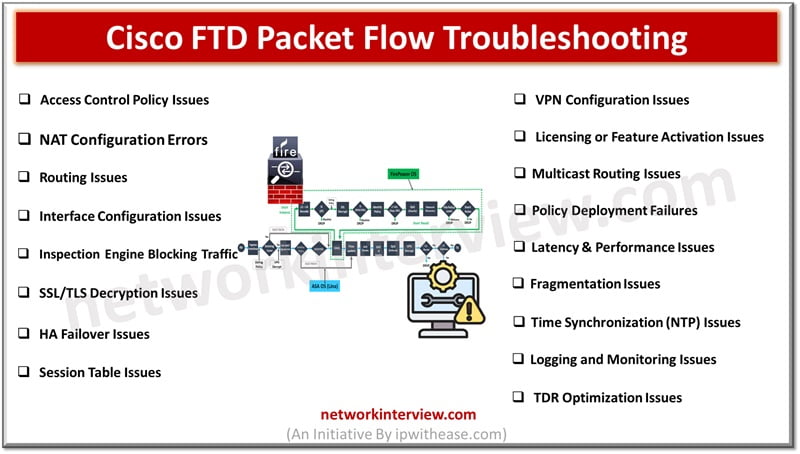
Cisco FTD Packet Flow Troubleshooting: Common Issues
Troubleshooting Cisco FTD Packet Flow issues can be complex. Here is a summary of common Cisco FTD Packet Flow troubleshooting issues and the associated troubleshooting steps.
Cisco FTD Packet Flow Troubleshooting Issues
1. Access Control Policy Issues
- Issue: Traffic is dropped due to incorrect or missing access control rules.
- Troubleshooting:
- Verify the access control policy using Firepower Management Center (FMC).
- Use system support trace and packet-tracer to trace packet flow through policies.
- Check the logs for denied or dropped traffic.
2. NAT Configuration Errors
- Issue: Traffic fails due to incorrect or missing NAT rules.
- Troubleshooting:
- Review NAT rules in FMC.
- Use packet-tracer to simulate packet flow through NAT.
- Check show nat detail to inspect NAT rule matches and translations.
3. Routing Issues
- Issue: Packets not reaching the destination due to routing misconfigurations.
- Troubleshooting:
- Verify the routing table using show route.
- Use ping and traceroute to test network connectivity.
- Ensure static or dynamic routing (e.g., OSPF, BGP) is properly configured.
4. Interface Configuration Issues
- Issue: Traffic dropped due to interface misconfiguration or VLAN mismatches.
- Troubleshooting:
- Verify interface configurations using show interface and show vlan.
- Ensure VLAN tagging is correct and matches the upstream switch configuration.
- Use packet-tracer to confirm interface behavior.
5. Inspection Engine Blocking Traffic
- Issue: Legitimate traffic dropped by FTD’s deep packet inspection engine (IPS, URL Filtering, Malware Protection).
- Troubleshooting:
- Review inspection settings in the FMC.
- Check logs for inspection-related traffic drops.
- Create bypass rules or tune inspection settings if false positives are identified.
6. SSL/TLS Decryption Issues
- Issue: SSL/TLS traffic is dropped due to decryption issues.
- Troubleshooting:
- Review SSL policy configurations in FMC.
- Check logs for SSL decryption failures.
- Use packet captures (capture) to verify SSL traffic behavior.
7. High Availability (HA) Failover Issues
- Issue: Traffic disruption during failover or synchronization issues in an HA environment.
- Troubleshooting:
- Check HA status with show failover and show failover history.
- Ensure proper synchronization between HA members.
- Use packet captures during failover events to analyze traffic flow.
8. Session Table Issues
- Issue: Traffic dropped due to incorrect session handling or session table overflow.
- Troubleshooting:
- Check session entries with show conn.
- Clear sessions if needed with clear conn.
- Review session timeout settings and adjust if necessary.
9. VPN Configuration Issues
- Issue: VPN tunnels fail to establish or traffic is dropped within the VPN.
- Troubleshooting:
- Verify VPN settings (phase 1/2) using show crypto ikev2 sa and show vpn-sessiondb.
- Review logs for VPN negotiation failures.
- Use packet-tracer to simulate VPN packet flow.
10. Licensing or Feature Activation Issues
- Issue: Traffic blocked or features disabled due to expired licenses or unlicensed features.
- Troubleshooting:
- Verify licenses with show license.
- Ensure that all necessary licenses (e.g., Threat, URL Filtering, Malware) are installed and valid.
- Review logs for traffic blocked due to feature limitations.
11. Multicast Routing Issues
- Issue: Multicast traffic not being forwarded due to incorrect multicast configuration.
- Troubleshooting:
- Verify multicast routing configurations with show igmp and show pim.
- Ensure multicast traffic is routed correctly through the interfaces.
- Use packet captures to analyze multicast traffic flow.
12. Policy Deployment Failures
- Issue: Changes made in FMC are not deployed correctly to FTD devices.
- Troubleshooting:
- Check deployment status in FMC to ensure policies are applied.
- Use system support diagnostic-cli to check the FTD device for errors.
- Review the deployment log for errors or misconfigurations.
13. Latency and Performance Issues
- Issue: Traffic delays or performance degradation due to excessive inspection or resource overload.
- Troubleshooting:
- Monitor resource utilization using show cpu usage and show memory.
- Review inspection profiles and disable unnecessary features.
- Use capture to analyze packet latency and response times.
14. Fragmentation Issues
- Issue: Fragmented packets being dropped or mishandled.
- Troubleshooting:
- Adjust the Maximum Transmission Unit (MTU) on interfaces if necessary.
- Use capture to analyze packet fragments.
- Ensure fragmented packet handling is configured in the firewall policy.
15. Time Synchronization (NTP) Issues
- Issue: NTP time synchronization issues causing logging and event correlation problems.
- Troubleshooting:
- Verify NTP configuration using show ntp and ensure synchronization is working.
- Check logs for time drift issues.
- Correct NTP server settings if necessary.
16. Logging and Monitoring Issues
- Issue: Insufficient logging or missing events in logs, making troubleshooting difficult.
- Troubleshooting:
- Ensure logging is enabled for relevant access control and inspection rules.
- Use show logging and review FMC to confirm logs are properly recorded.
- Increase logging verbosity if needed for detailed analysis.
17. Threat Defense Rule Optimization Issues
- Issue: Rules not optimized, leading to traffic being dropped or misrouted.
- Troubleshooting:
- Review rule order and optimization in the FMC.
- Use system support trace to trace traffic and ensure it follows the intended path.
- Reorder or refine rules to improve performance and accuracy.
These issues can typically be diagnosed using Cisco’s built-in tools like packet-tracer, capture, show conn, and system support trace, along with detailed analysis in Firepower Management Center.
Tag:ftd, troubleshoot



